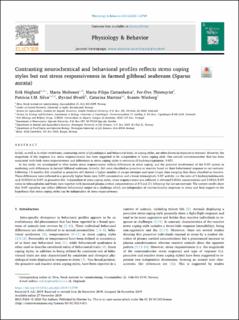| dc.description.abstract | In fish, as well as in other vertebrates, contrasting suites of physiological and behavioral traits, or coping styles, are often shown in response to stressors. However, the magnitude of the response (i.e. stress responsiveness) has been suggested to be independent of stress coping style. One central neurotransmitter that has been associated with both stress responsiveness and differences in stress coping styles is serotonin (5-hydroxytryptamine, 5-HT). In this study, we investigated to what extent stress responsiveness reflects differences in stress coping, and the potential involvement of the 5-HT system in mediating such differences in farmed Gilthead seabream. Initially, fish were classified as proactive or reactive based on their behavioural response to net restraint. Following 1.5 months, fish classified as proactive still showed a higher number of escape attempts and spent longer time escaping than those classified as reactive. These differences were reflected in a generally higher brain stem 5-HT concentration and a lower telencephalic 5-HT activity, i.e. the ratio of 5-hydroxyindoleacetic acid (5-HIAA) to 5-HT, in proactive fish. Independent of stress coping styles, stress responsiveness was reflected in elevated 5-HIAA concentrations and 5-HIAA/5-HT ratios in telencephalon and brain stem together with increased plasma cortisol concentrations at 0.5 and 2 h following the last net restraint. The current results show that 5-HT signaling can reflect different behavioural output to a challenge which are independent of neuroendocrine responses to stress and lend support to the hypothesis that stress coping styles can be independent of stress responsiveness. | |
